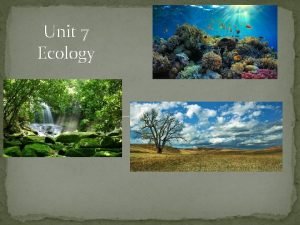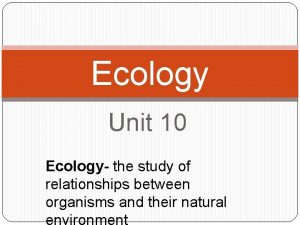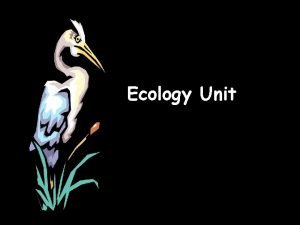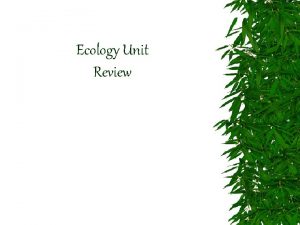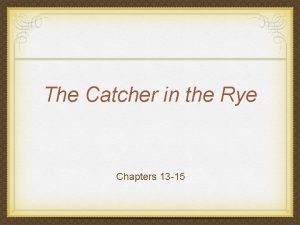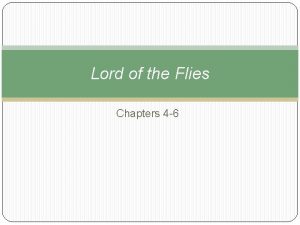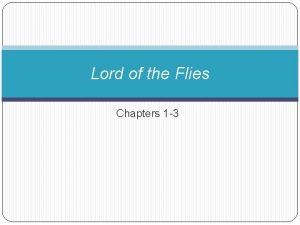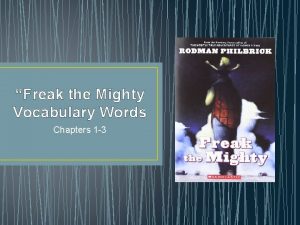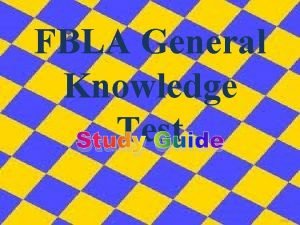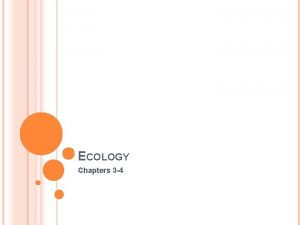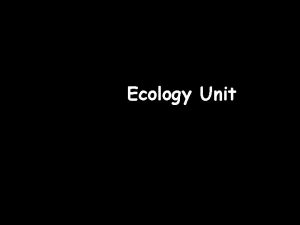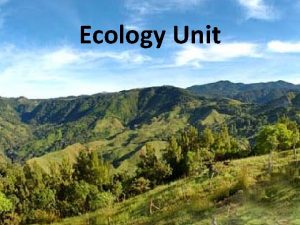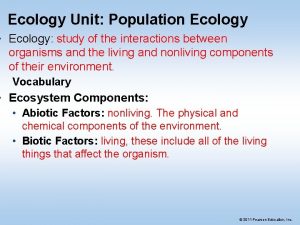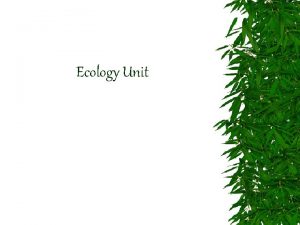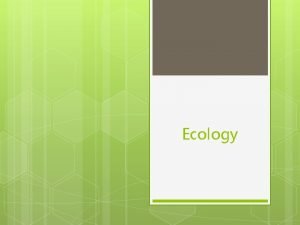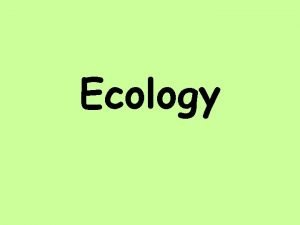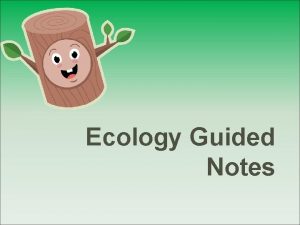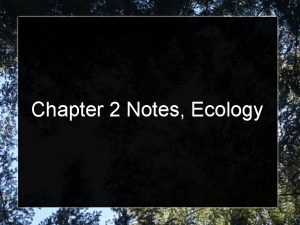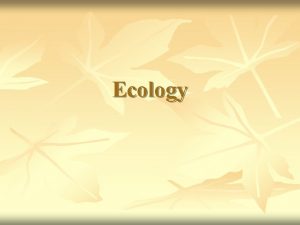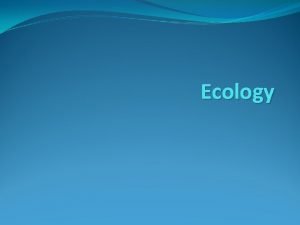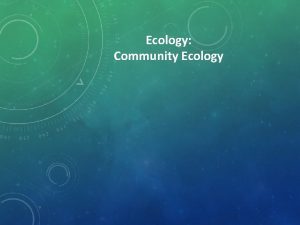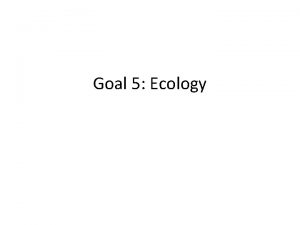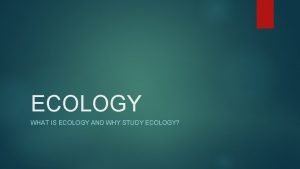Unit Five ECOLOGY Chapters 34 36 37 38

































































- Slides: 65

Unit Five: ECOLOGY (Chapters 34, 36, 37 & 38) Chapter 34 – The Biosphere Chapter 36 – Population Ecology Chapter 37 – Communities & Ecosystems Chapter 38 – Conservation Biology

Chapter 34 The Biosphere: An introduction to Earth’s Diverse Environments Power. Point Lectures for Campbell Biology: Concepts & Connections, Seventh Edition Reece, Taylor, Simon, and Dickey © 2012 Pearson Education, Inc. Lecture by Edward J. Zalisko

Figure 34. 0_2 Chapter 34: Big Ideas The Biosphere Terrestrial Biomes Aquatic Biomes

Introduction § For most of life on Earth, the sun is the main source of energy. § From the roof of the world to the deepest oceans, Earth’s diverse environments are bursting with life. § But around hydrothermal vents, organisms have evolved to use energy from chemicals – These organisms are called chemoautotrophs. Eg: sulfur bacteria. These bacteria obtain energy by oxidizing hydrogen sulfide. © 2012 Pearson Education, Inc.

Tube worms (Riftia pachyptila) near hydrothermal vent These are heterotrophs that depend on sulfur bacteria

Figure 34. 0_3 The rocky slopes of the eastern Himalayas

THE BIOSPHERE The biosphere extends from the atmosphere several kilometers above the earth to the depth of the oceans The biosphere is composed of living communities and nonliving physical and chemical factors. Biospehre is all of the Earth that is inhabited by life. © 2012 Pearson Education, Inc.


34. 1 Ecologists study how organisms interact with their environment at several levels § Ecology is the scientific study of the interactions of organisms with their environments. © 2012 Pearson Education, Inc.

34. 1 Ecologists study how organisms interact with their environment at several levels § Ecologists study environmental interactions at the levels of the – organism, – population, a group of individuals of the same species living in a particular geographic area, – community, an assemblage of all the populations of organisms living close enough together for potential interaction, and – ecosystem, both the abiotic and biotic components of the environment. © 2012 Pearson Education, Inc.

Figure 34. 1 A Organism

Figure 34. 1 B Population Group of individuals of the same species living in a particular geographic area

Figure 34. 1 C Community All populations of organisms living in a geographic area

Figure 34. 1 D Ecosystem Includes both biotic and abiotic components of the environment

34. 1 Ecologists study how organisms interact with their environment at several levels § An organism’s habitat includes the biotic and abiotic factors present in its surroundings. § Organisms are affected by both biotic and abiotic factors. 1. Biotic factors include all of the organisms in an area, the living component of the environment. 2. Abiotic factors are the environment’s nonliving component, the physical and chemical factors. © 2012 Pearson Education, Inc.

34. 3 Physical and chemical factors influence life in the biosphere § The most important abiotic factors that determine the biosphere’s structure and dynamics include – the energy source, usually solar energy, – temperature, – abundance and type of water, – nutrients, – other aquatic factors such as availability of oxygen, and – other terrestrial factors including wind and fire. © 2012 Pearson Education, Inc.

34. 2 CONNECTION: The science of ecology provides insight into environmental problems § Human activities affect all parts of the biosphere. – Cities, farms, and highways change the landscape. – The widespread use of chemicals such as fertilizers and pesticides poses problems to people and other organisms. © 2012 Pearson Education, Inc.

Figure 34. 2 A

34. 2 CONNECTION: The science of ecology provides insight into environmental problems § Two events raised questions about the long-term effects of widespread DDT use. 1. The evolution of pesticide resistance in insects and 2. Rachel Carson’s 1962 book Silent Spring, which played a key role in the awakening of environmental awareness. © 2012 Pearson Education, Inc.

Figure 34. 3 A The respiratory surface of a giant tube worm A snowy owl

34. 4 EVOLUTION CONNECTION: Organisms are adapted to abiotic and biotic factors by natural selection § One of the fundamental goals of ecology is to explain the distribution of organisms. § The presence of a species in a particular place has two possible explanations. 1. The species may have evolved from ancestors living in that location, or 2. it may have dispersed to that location and been able to survive once it arrived. © 2012 Pearson Education, Inc.

34. 4 EVOLUTION CONNECTION: Organisms are adapted to abiotic and biotic factors by natural selection § The pronghorn is a highly successful herbivorous running mammal of open country. – It is a descendent of ancestors that roamed the open plains and shrub deserts of North America more than a million years ago. – It is found nowhere else and is only distantly related to the many antelope species in Africa. © 2012 Pearson Education, Inc.

34. 4 EVOLUTION CONNECTION: Organisms are adapted to abiotic and biotic factors by natural selection § A pronghorn’s habitat is arid, windswept, and subject to extreme temperature fluctuations. § Their ability to survive and reproduce under these conditions left offspring that carried their alleles into subsequent generations. § Until around 12, 000 years ago, one of their major predators was probably the now extinct American cheetah, similar to African cheetahs alive today. © 2012 Pearson Education, Inc.

34. 4 EVOLUTION CONNECTION: Organisms are adapted to abiotic and biotic factors by natural selection § Ecologists hypothesize that the selection pressure of the cheetah’s pursuit led to the pronghorn’s blazing speed, which far exceeds that of its main present-day predator, the wolf. § Like many large herbivores that live in open grasslands, the pronghorn also derives protection from living in herds. § Populations of organisms are adapted to local environmental conditions, which may limit the distribution of organisms. © 2012 Pearson Education, Inc.

Biomes of the world • A biome is a major ecological association that occupy a broad geographic regions of land or water. • Aquatic biomes marine - oceans fresh water –lakes, ponds rivers • Terrestrial biomes categorized by climate and plant life Copyright © 2009 Pearson Education, Inc.

AQUATIC BIOMES © 2012 Pearson Education, Inc.

34. 6 Sunlight and substrate are key factors in the distribution of marine organisms – Oceans cover about 75% of the Earth’s surface § Aquatic biomes are shaped by the availability of – light and – nutrients. © 2012 Pearson Education, Inc.

Figure 34. 6 A Ocean life (zone depths and organisms not drawn to scale) High tide Low tide Pelagic realm (open water) Sea star (to 33 cm) Intertidal zone Man-of-war (to 50 m long) Oarweed (to 2 m) Brain coral (to 1. 8 m) Phytoplankton Turtle (60 180 cm) Zooplankton Blue shark (to 2 m) Photic zone 200 m Continental shelf Sponges (1 cm 1 m) Sperm whale (10 20 m) Sea pen (to 45 cm) Benthic realm (seafloor from continental shelf to deep-sea bottom) Octopus (to 10 m) Sea spider (1 90 cm) Hatchet fish (2 60 cm) Rat-tail fish (to 80 cm) Gulper eel (to 180 cm) Angler fish (45 cm 2 m) Brittle star (to 60 cm) Glass sponge (to 1. 8 m) Sea cucumber (to 40 cm) “Twilight” Tripod fish (to 30 cm) 1, 000 m Aphotic zone No light 6, 000 10, 000 m

34. 6 Sunlight and substrate are key factors in the distribution of marine organisms § Within the oceans are the – pelagic realm, which includes all open water, – benthic realm, which consists of the seafloor, – aphotic zone, where there is insufficient light for photosynthesis, and – photic zone, where light penetration is sufficient for photosynthesis and phytoplankton can occur. – Zooplankton are abundant in the pelagic photic zone. – Coral reefs also occur in the photic zone. © 2012 Pearson Education, Inc.

Figure 34. 6 B A coral reef with its immense variety of invertebrates and fishes

34. 6 Sunlight and substrate are key factors in the distribution of marine organisms § The marine environment includes distinctive biomes where the ocean meets the land or fresh water. – Intertidal zones are where the ocean meets the land the shore is – pounded by waves during high tide and – exposed to the sun and drying winds during low tide. – Estuaries are productive areas where rivers meet the ocean. – Wetlands are transitional between aquatic and terrestrial ecosystems. © 2012 Pearson Education, Inc.

Figure 34. 6 D An estuary in Georgia

Consequences of human activities § Increased use of agricultural fertilizers can lead to dead zones in oceans

34. 7 Current, sunlight, and nutrients are important abiotic factors in freshwater biomes § Freshwater biomes – cover less than 1% of the Earth, – contain less than 0. 01% of its water, – harbor 6% of all described species, and – include lakes, ponds, rivers, streams, and wetlands. © 2012 Pearson Education, Inc.

34. 7 Current, sunlight, and nutrients are important abiotic factors in freshwater biomes § Freshwater biomes fall into two broad groups: 1. standing water biomes (lakes and ponds) and 2. flowing water biomes (rivers and streams). © 2012 Pearson Education, Inc.

Figure 34. 7 A Zones in a lake Photic zone Benthic realm Aphotic zone

Figure 34. 7 B A stream in the Great Smoky Mountains, Tennessee

Figure 34. 7 C A marsh at Kent State University in Ohio

TERRESTRIAL BIOMES (self study) © 2012 Pearson Education, Inc.

34. 8 Terrestrial biomes reflect regional variations in climate § Terrestrial ecosystems are grouped into nine major types of biomes, distinguished primarily by their predominant vegetation. § The geographic distribution of plants and thus terrestrial biomes largely depends on climate. The key climate factors are – temperature and – precipitation § The same type of biome may occur in geographically distant places if the climate is similar. © 2012 Pearson Education, Inc.

34. 8 Terrestrial biomes reflect regional variations in climate § The current concern about global warming is generating intense interest in the effect of climate on vegetation patterns. § Scientists are documenting – latitudinal shifts in biome borders and snow and ice coverage and – changes in length of the growing season. © 2012 Pearson Education, Inc.

Figure 34. 8 30 N Tropic of Cancer Tropic of Capricorn Equator 30 S Key Tropical forest Chaparral Coniferous forest Savanna Temperate grassland Arctic tundra Desert Temperate broadleaf forest Polar ice High mountains (coniferous forest and alpine tundra)

34. 9 Tropical forests cluster near the equator § Tropical forests – occur in equatorial areas, – experience warm temperatures and days that are 11– 12 hours long year-round, and – have variable rainfall. © 2012 Pearson Education, Inc.

34. 9 Tropical forests cluster near the equator § The tropical rain forest is among the most complex of all biomes. – Tropical rain forests harbor enormous numbers of species. – Large-scale human destruction of tropical rain forests continues to endanger many species. © 2012 Pearson Education, Inc.

Figure 34. 9

34. 10 Savannas are grasslands with scattered trees § Savannas – are warm year-round, – have 30– 50 cm annual rainfall, – experience dramatic seasonal variation, – are dominated by grasses and scattered trees, and – are mostly inhabited by large grazing mammals and insects. © 2012 Pearson Education, Inc.

Figure 34. 10

34. 11 Deserts are defined by their dryness § Deserts are the driest of all terrestrial biomes. – They are characterized by low and unpredictable rainfall. – Desertification, the conversion of semiarid regions to desert, is a significant environmental problem. © 2012 Pearson Education, Inc.

Figure 34. 11

34. 12 Spiny shrubs dominate the chaparral § The chaparral is a shrubland with – cool, rainy winters and – hot, dry summers. – Vegetation is adapted to periodic fires. © 2012 Pearson Education, Inc.

Figure 34. 12

34. 13 Temperate grasslands include the North American prairie § Temperate grasslands – are mostly treeless, except along rivers or streams, – experience precipitation of about 25– 75 cm per year, with periodic droughts and cold winters, and – in North America have historically been grazed by large bison and pronghorn. – Farms have replaced most of North America’s temperate grasslands. © 2012 Pearson Education, Inc.

Figure 34. 13

34. 14 Broadleaf trees dominate temperate forests § Temperate broadleaf forests – grow where there is sufficient moisture to support the growth of large trees and – experience wide-ranging temperatures (– 30°C to 30°C) and high annual precipitation (75– 150 cm). – Nearly all of the original broadleaf forests in North America have been drastically altered by agriculture and urban development. © 2012 Pearson Education, Inc.

Figure 34. 14

34. 15 Coniferous forests are often dominated by a few species of trees § Cone-bearing evergreen trees, such as spruce, pine, fir, and hemlock, dominate coniferous forests. § The northern coniferous forest, or taiga, is the largest terrestrial biome on Earth. The taiga is characterized by – long, cold winters and – short, wet summers. § Temperate rain forests of coastal North America are also coniferous forests. © 2012 Pearson Education, Inc.

Figure 34. 15

34. 16 Long, bitter-cold winters characterize the tundra § The tundra covers expansive areas of the Arctic between the taiga and the permanently frozen polar ice. § The treeless arctic tundra – is characterized by permafrost, continuously frozen subsoil, and – experiences little precipitation. © 2012 Pearson Education, Inc.

Figure 34. 16

34. 17 Polar ice covers the land at high latitudes § Polar ice covers – land north of the tundra, – much of the Arctic Ocean, and – the continent of Antarctica. § Temperatures are extremely cold year-round and precipitation is very low. § The terrestrial polar biome is closely intertwined with the neighboring marine biome. © 2012 Pearson Education, Inc.

Figure 34. 17

34. 18 The global water cycle connects aquatic and terrestrial biomes § Ecological subdivisions such as biomes are linked by – nutrient cycles and – the water cycle. – Water in the form of precipitation and evaporation moves between the land, oceans, and atmosphere. – Over the oceans, evaporation exceeds precipitation. – Over the land, precipitation exceeds evaporation. © 2012 Pearson Education, Inc.

34. 18 The global water cycle connects aquatic and terrestrial biomes § Human activities affect the global water cycle. – The destruction of tropical rain forests reduces the amount of water vapor in the air. – Pumping large amounts of groundwater to the surface for irrigation increases the rate of evaporation over land. © 2012 Pearson Education, Inc.

Figure 34. 18 Solar heat Water vapor over the sea Precipitation over the sea Net movement of water vapor by wind Evaporation from the sea Evaporation and transpiration Water vapor over the land Precipitation over the land Oceans Flow of water from land to sea Surface water and groundwater

Figure 34. UN 01 Reviewing the Concepts, 34. 1 Organismal ecology (individual) Population ecology (group of individuals of a species) Community ecology (all organisms in a particular area) Ecosystem ecology (all organisms and abiotic factors)
 Portia nelson autobiography in five short chapters
Portia nelson autobiography in five short chapters The fox and the goat setting diagram
The fox and the goat setting diagram Unit 7 ecology answer key
Unit 7 ecology answer key Unit 7 ecology answer key
Unit 7 ecology answer key Unit 5 ecology
Unit 5 ecology Unit 10 ecology
Unit 10 ecology Ecology unit review
Ecology unit review Sulfur oxide
Sulfur oxide Five years have past five summers with the length
Five years have past five summers with the length Five of five
Five of five Five elements and five senses
Five elements and five senses Macbeth seyton i am sick at heart
Macbeth seyton i am sick at heart Unit 6 review questions
Unit 6 review questions The watsons go to birmingham vocabulary chapters 1-3
The watsons go to birmingham vocabulary chapters 1-3 Tuesday with morrie chapter 1
Tuesday with morrie chapter 1 The catcher in the rye chapter 6 quotes
The catcher in the rye chapter 6 quotes To kill a mockingbird quiz chapters 1 11
To kill a mockingbird quiz chapters 1 11 To kill a mockingbird chapters 1-6 quiz
To kill a mockingbird chapters 1-6 quiz Chapters 4-7 to kill a mockingbird summary
Chapters 4-7 to kill a mockingbird summary To kill a mockingbird quiz chapters 4-6
To kill a mockingbird quiz chapters 4-6 To kill a mockingbird 28-31 summary
To kill a mockingbird 28-31 summary Chapter 27 questions to kill a mockingbird
Chapter 27 questions to kill a mockingbird Tkam chapter 24 summary
Tkam chapter 24 summary Chapter 12 to kill a mocking bird
Chapter 12 to kill a mocking bird To kill a mockingbird chapter 10 and 11 summary
To kill a mockingbird chapter 10 and 11 summary Chapters 1-5 to kill a mockingbird summary
Chapters 1-5 to kill a mockingbird summary To kill a mockingbird first chapter summary
To kill a mockingbird first chapter summary Analogous in to kill a mockingbird
Analogous in to kill a mockingbird Things fall apart summary 4-6
Things fall apart summary 4-6 Chapter 17 things fall apart summary
Chapter 17 things fall apart summary Things fall apart 14-16
Things fall apart 14-16 Village by the sea chapter 2 summary
Village by the sea chapter 2 summary Chapters 11-12 scarlet letter
Chapters 11-12 scarlet letter The reluctant fundamentalist chapter 4
The reluctant fundamentalist chapter 4 Reluctant fundamentalist chapter summary
Reluctant fundamentalist chapter summary Marketing process steps
Marketing process steps The hunger games chapter 22 questions and answers
The hunger games chapter 22 questions and answers The hiding place chapter 7
The hiding place chapter 7 Chapter 8 summary gatsby
Chapter 8 summary gatsby Summary chapter 3 great gatsby
Summary chapter 3 great gatsby Catcher in the rye chapter 13 quotes
Catcher in the rye chapter 13 quotes Catcher in the rye 1-3 summary
Catcher in the rye 1-3 summary Noughts and crosses chapter 11 summary
Noughts and crosses chapter 11 summary Summary of red kayak
Summary of red kayak Percy jackson vocabulary chapters 5-8
Percy jackson vocabulary chapters 5-8 Chapter 4 night discussion questions
Chapter 4 night discussion questions Biomedical waste management nabh
Biomedical waste management nabh Frankenstein chapter summaries 11-16
Frankenstein chapter summaries 11-16 Frankenstein chapter 11
Frankenstein chapter 11 Summary of chapters 4-6 lord of the flies
Summary of chapters 4-6 lord of the flies Lord of the flies chapters 1-3
Lord of the flies chapters 1-3 Figurative language in hatchet chapter 5-6
Figurative language in hatchet chapter 5-6 Good to great chapter 2
Good to great chapter 2 Freak the mighty vocabulary chapters 1-5
Freak the mighty vocabulary chapters 1-5 Fever 1793 chapter 24
Fever 1793 chapter 24 The fbla-pbl national center is located where?
The fbla-pbl national center is located where? How many chapters in ender's game
How many chapters in ender's game Chapter 20 of things fall apart
Chapter 20 of things fall apart Candide chapter 27
Candide chapter 27 A brave new world chapter 4 summary
A brave new world chapter 4 summary Brave new world chapter 1
Brave new world chapter 1 Mrs. pratchett
Mrs. pratchett Ashtanga hridaya chapter 3
Ashtanga hridaya chapter 3 What is a harami in a thousand splendid suns
What is a harami in a thousand splendid suns Touching spirit bear chapters 1-2 answers
Touching spirit bear chapters 1-2 answers Main idea and supporting details definition
Main idea and supporting details definition


